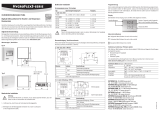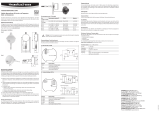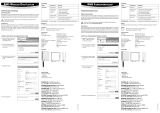Page is loading ...

12.0703.0001
ROTRONIC AG, CH-8303 Bassersdorf
Tel. +41 44 838 11 44, www.rotronic.com
ROTRONIC Messgeräte GmbH, D-76275 Ettlingen
Tel. +49 7243 383 250, www.rotronic.de
ROTRONIC SARL, 56, F - 77183 Croissy Beaubourg
Tél. +33 1 60 95 07 10, www.rotronic.fr
ROTRONIC Italia srl
, I- 20157 Milano
Tel. +39 2 39 00 71 90, www.rotronic.it
ROTRONIC Instruments (UK) Ltd, West Sussex RH10 9EE
Phone +44 1293 571000, www.rotronic.co.uk
ROTRONIC Instrument Corp, NY 11788, USA
Phone +1 631 427-3898, www.rotronic-usa.com
ROTRONIC South East Asia Pte Ltd, Singapore 339156
Phone +65 6294 6065, www.rotronic.com.sg
ROTRONIC Shanghai Rep. Office, Shanghai 200233, China
Phone +86 40 08162018, www.rotronic.cn
We congratulate you on the purchase of your new ROTRONIC GTS measuring
instrument. Please read these short instructions carefully before you use the
device.
1. Introduction
The handheld instrument GTS is a robust instrument for the measurement of
equilibrium humidity and temperature of paper and cardboard stacks etc. It
may also be used for the measurement of the ambient relative humidity and
temperature.
2. Technical description
The humidity is measured with a capacitive ROTRONIC HYGROMER AC-1 sen-
sor.
The capacity of the sensor changes with the relative humidity. These changes
are detected, amplified and displayed using advanced electronics. For the
temperature measurement, a Pt100 sensor is used.
3. Setting to work
Before using, a standard 9 V disposable or rechargeable battery must be placed
in the compartment at the back of the instrument. It is preferable to use leak
proof batteries with a high storage capacity, such as e.g. alkali cells. Leaking
batteries can destroy the instrument.
Functions
ON Press pushbutton
Switching rh / Temp Press pushbutton shortly
OFF Press pushbutton and hold until display goes off
Display rh or Temp 3-digit LCD readout ( % RH or °C, indicated by a
mark on the left side of the display)
Battery test The sign in front of %RH or °C is flashing when
the battery has to be changed.
Humidity adjustment Potentiometer on the front side, covered
by a small round cap.
4. Performance of measurements
The instruments are factory- adjusted; which means that a calibration after
receipt of the instrument is not necessary. After switching on, the instrument is
immediately ready for the measurement. The waiting time before you can read
the measured humidity and temperature depends only on the acclimatization
time of the probe and the medium to be measured. The acclimatization concerns
both humidity and temperature. During the acclimatization which can last from
a few up to 30 minutes, the instrument does not have to be switched on.
The necessary time depends on:
- Difference in humidity and temperature between sensor and medium to be
measured
- Change of the measured variables during the acclimatization.
Humidity measurement provides a better picture of the progress of acclimatiza-
tion since it responds much faster and more sensitively than the temperature
measurement. Hence the 1/10 percent indication is particularly suitable as a
trend indicator. The acclimatization may be considered as terminated, when the
indication oscillates around a mean value. As it cannot be emphasised enough
that accurate humidity measurements are extremely demanding, some of the
most frequent errors are mentioned below:
4.1 Sources of errors
- Temperature errors caused by too short adaptation time
- Exposure to sun radiation during measurement, or the presence of radiators,
cold outside-oriented wall, draught, heat radiated from body etc.
- Humidity errors due to sprayed steam / vapour or water, dripping water,
attempts to measure non-hygroscopic substances, condensation.
- Contamination of the sensor with dust
- Discharged battery. The battery voltage drops considerably at temperatures
below 10 °C.
- The instrument is out of the specified accuracy and has to be adjusted.
See item 5.
Handheld instrument for
paper / cardboard stacks
Instruction Manual
If condensation occurs, the instrument will indicate a higher value than 99.9 %rh
(= max. value); therefore the indication changes to 0 %rh and may even go higher,
depending on the condensation. Condensation does not destroy or damage the
humidity sensor. For the regeneration of the instrument, remove it from the humid
ambient and keep it in a warm and dry place.
The sensors are insensitive to chemicals as long as they occur in the normal
concentrations (MAC values = Maximum Allowable Concentration). Consult
the manufacturer in case of higher concentrations.
After the measurement has been carried out, we recommend to put the instru-
ment back into the case or in another place where it is protected against dust.
4.2 Measurement in paper stacks
The GTS instrument is specially designed for carrying out measurements in
paper stacks. It represents a design optimum between the smallest possible
thermal capacity, sufficiently high mechanical strength and good heat transfer
between paper and sensor. To introduce the probe into the stack, the layer of
paper above the desired measuring location must be slightly lifted. Friction
between the probe-blade and the paper should be kept to a minimum since
this will generate unnecessary heat and extend the measuring time. The same
precautionary measures are necessary when the probe-blade is withdrawn
from the paper stack in order to measure another one. During the measure-
ment it is recommended to move the probe by a few mm after approx. 30 sec.
so that the opening comes into contact with fresh paper. This will speed up the
measurement because the quantity of water required for the measurement is
supplied to the sensor more quickly. Avoid touching the probe-blade with the
hand (temperature influence).
The instrument will automatically switch off after about 2 minutes. Switch it on
again if necessary.
4.3 Measurement of ambient humidity and temperature
The GTS instrument, though it is designed for the measurement of paper stacks,
may also be used for the measurement of the ambient. In order to get accurate
measurements, it is important to acclimatize the instrument for a period of time,
as the air is a good insulator (low temperature conductivity). Avoid touching the
sword with your hands (temperature influence). Do not use the instrument in an
air flow above 3 m/s, as the probe is not protected by a filter.
5. Maintenance and service
5.1 Temperature probe
The instruments are factory- adjusted. A temperature re-adjustment is normally
not required.In case of doubts concerning the correct adjustment, please contact
ROTRONIC AG.
5.2.Humidity probe
We recommend to check the instrument at least once per year in order to keep
the specified accuracy. Use only ROTRONIC humidity standards to carry out
this check!
The humidity standards are ampoules, which contain unsaturated salt solutions,
for which we guarantee a shelf life time of 10 years.The nominal value, e.g. 50
%rh, is reached at 23 °C. Therefore we recommend to do the calibration at 23
± 2 °C. If the ambient temperature is higher or lower, you have to consider the
corresponding humidity, indicated on the cover of the humidity standards.
The GTS-Set consists of a carrying case, containing the instrument, humidity
standards and the calibration device required for humidity calibration.
If you do not have these accessories, you can order them from ROTRONIC or a
ROTRONIC agent. (See accessories, item 6).
The ROTRONIC humidity standards (CH poison class 3) are normally not dan-
gerous for men but can cause irritations of the skin of sensitive persons. In
case of contact with your skin or eyes, immediately wash out the solution
thoroughly with plenty of water. The ROTRONIC humidity standards must not
be swallowed!
Definitions:
Calibration = Control measurement with a ROTRONIC humidity standard
Adjustment = Calibration + additional new adjustment to the nominal value
Attention!
The instrument is designed for a 1-point adjustment; it should therefore be
calibrated in the range it’s normally used in. In the paper industry, this is usu-
ally 50 %rh.
Calibration steps for humidity measurement:
- Unscrew the knurled screw cap of the calibration device.
- Insert the rubber sealings corresponding to the sword form. Also see instructions
coming with the calibration device.
- Insert the probe fully into the calibration device. Make sure the opening is
lookung downwards.
- Take a textile pad from the box of the humidity standards and put it into the
cover of the calibration device. Before breaking the ampoule, hold it by the
neck and shake slightly, until all the fluid is in the lower part. Then break off
at the constriction between neck and body. Pour all the contents into the
middle of the textile pad, slightly tapping if necessary to ensure complete
emptying.
- Hold the probe and the calibration device with the opening facing down and
screw the cover back in its original position and after this operation.
- Allow sufficient acclimatisation time (45 – 50 min.) before checking the
indication.
- Remove the small, round cap on the front side and adjust the potentiometer
with a screwdriver, till the reading equals the value of the humidty standard.
- After calibration, remove the textile pad and dispose of it with the household
refuse.
The textile pads are designed for one-time use and must not be used again.
- Rinse the knurled cover with plenty of water and dry.
5.3 Contamination
In order to avoid contamination of the probe, the instrument should be placed
in the carrying case immediately after use.
6. Accessories
6.1 Humidity standards
Nominal value : Order code:
50 %rh EA50-SCS (standard value for paper measurement)
20 %rh EA20-SCS
35 %rh EA35-SCS
65 %rh EA65-SCS
80 %rh EA80-SCS
6.2 Calibration device
Calibration device for instrument GTS: Order Code: EGS
7. Technical data
Measuring range humidity 5…100 %rh
Measuring range temperature -10…50 °C
Accuracy of humidity at 23°C ± 1.5 %rh
Hysteresis for a 10-95-10 %rh cycle < 0.5 %rh
Time constant at 23 °C <10 sec.
System temperature coefficient ± 0.5 % rh (probe & electronics)
Humidity sensor Hygromer AC-1 capacitive sensor
Temperature sensor Pt 100 B
Display 3 digit LCD (%rh or °C/°F )
Resolution 0.1 % rh /0.1 °C
Supply
Battery 9 V, IEC 6LF22
Accumulator 8.4 V, 110 mAh, IEC 6F22
Lifetime battery / accumulator (typical) approx. 200 h / 50 h
Automatic cut-off after approx. 2 minutes
Battery indication low bat indication by flashing dot
Humidity adjustment potentiometer adjustment from outside
Probe material Aluminium
Probe dimensions 260 x 18 x 5 mm
Material of housing ABS
Weight approx. 300 g incl. battery
Dimensional diagram:
ROTRONIC GTS
/









